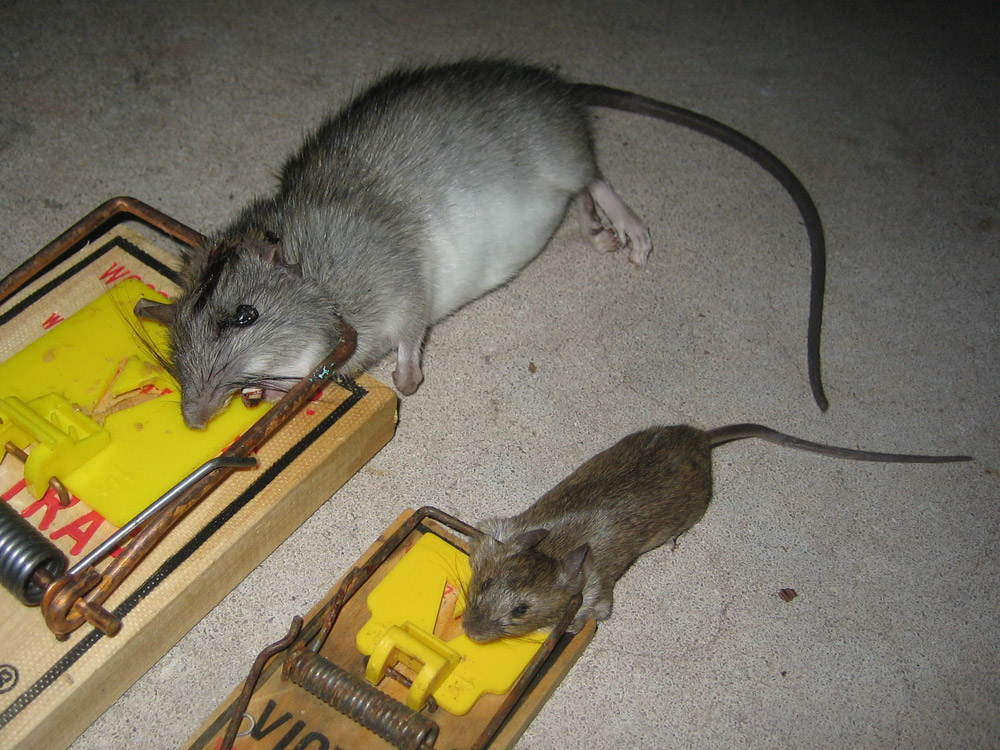|

 |
A roof rat and a house mouse. |
 |
Customer Rat Email: Hey John, Katia inquiring... left you a message day before yesterday but didn't hear back. Have a good news/bad news scenario: Good news is that that rat I heard when I called you out last has departed this earth in spirit and is no longer keeping me up at night. The bad news is, his earthly body didn't go with him and it's stinking up the master bedroom hallway! I've been up into the attic twice and he isn't in any of the traps. I've dug around the insulation in the area where the stench in emmanating from and am coming up empty and smell NOTHING in the attic itself. Which leads me believe that that little varmit may have crawled through the air ducts and died in one of the air ducts. It even occurred to me that when you resealed the duct, the little guy may have actually been trying to EXIT and couldn't because it was sealed (which would explain why the vent seemed intact to you), retreated, and eventually expired somewhere in the ductwork. I can pinpoint the rough vecinity of the carcass (smell is an amazing thing!), but beyond that, I can't find him. If we can't get to it, is there any way to get rid of this awful smell? We are beside ourselves! You know how high our ceilings are and I am hesitant to call you out to start carving up the ceiling, but obviously, we need to do something. Okay Rat Man (as you are fondly referred to at our house), what do you suggest? IF we have to wait this putrid thing out, any idea how long that bugger is going to decompose? Katia
My Answer: My name is David, not John. Regardless, dead rat odor tends to last about 4-7 days, and dead mouse odor 1-4 days.
If you need rodent control services in your hometown, click for the National Directory of
Rat Trappers that I've carefully compiled in every USA city.
There are three kinds of rodents commonly found inside buildings (in the attics, walls, and even inside the living space). They are the Roof Rat (Rattus rattus), which is also called the Black Rat, then there's the
Norway Rat (Rattus norvegicus), also known as the Brown Rat, and the House Mouse (Mus musculus). Roof Rats are more common in the south, such as Florida, where I work. The above photo is of a Roof Rat. They are very
common inside attics. The Norway Rat is more common in the northern section of the United States. The Norways are more commonly found underground, in subways and sewers and such. The House Mouse is found everywhere, but
seems more common in the north. All of these rodents thrive in urban areas and love to live in human buildings and houses. They use human garbage (and pantries) as sources of food. All of these rodents are carriers of
several diseases that can infect humans and pets. They contaminate homes and attics. The only way to permanently solve a rat problem is to find out how the rodents are gaining access to the inside of the building, and
fix those openings. Then the remaining rats inside have to be trapped and removed. If you want to learn more, please read my How To Get Rid of Rats page.
AAAnimal Control is a privately owned wildlife removal and pest control business, located in Orlando Florida. I deal strictly with wild animals such as rats. I am not an extermination company, but a critter removal
and control specialist. The above photos are some of the many that I've taken in the field over my years of work. Please email me if
you have any questions about the above photographs, or any questions about
wildlife problems or rat control issues.
| |
|